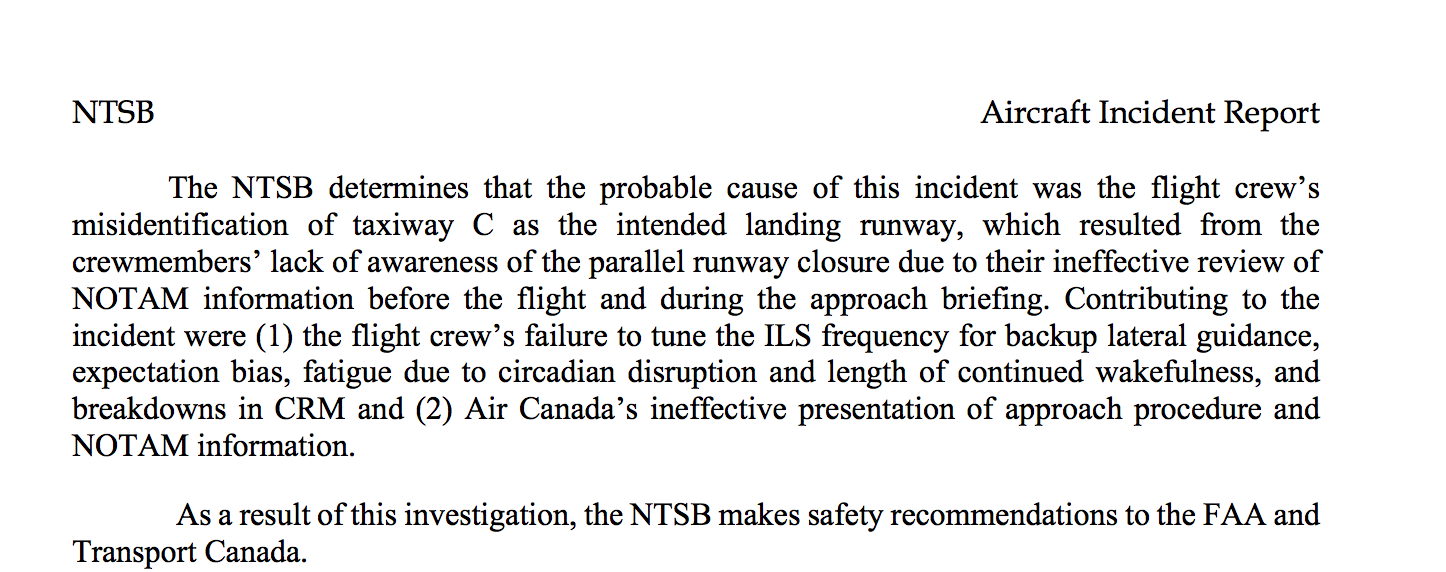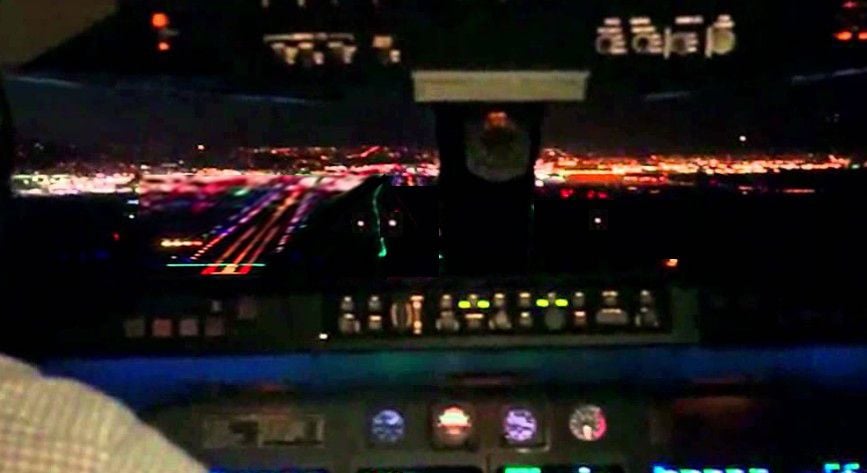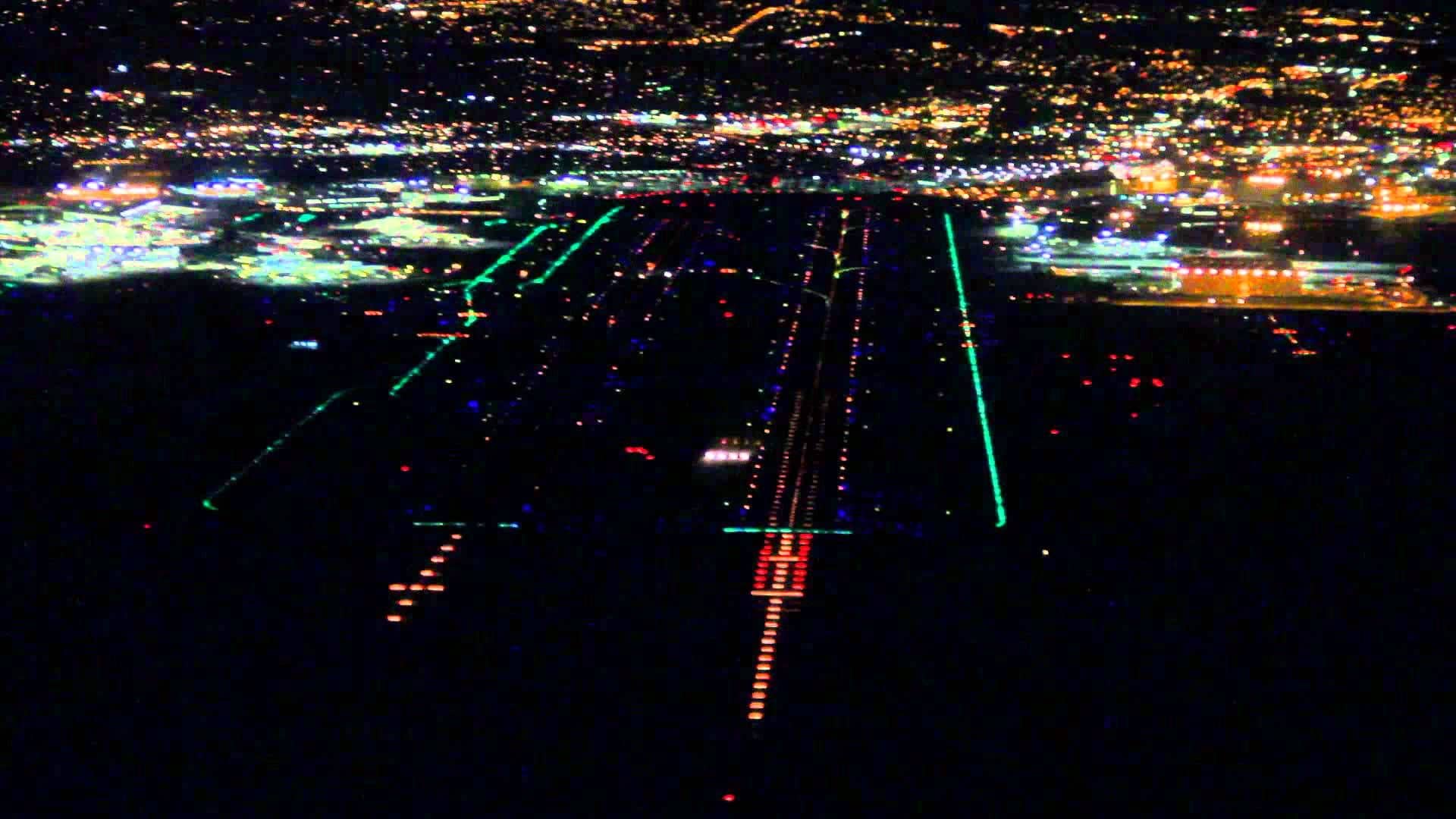Near miss with 5 airliners waiting for T/O on taxiway "C" in SFO!
In this incident, Airbus doesn't display the ILS for some types of approach by default, extra steps need to be taken, and they weren't. Not mandatory to have it displayed for the approach they were flying, but it would have given additional cues earlier that there was a problem.
Join Date: Aug 2007
Location: Auckland
Age: 52
Posts: 72
Likes: 0
Received 0 Likes
on
0 Posts
Unfortunately the report did not make any effort to setup the lights as they were and take a number of photos at varying distance from when the autopilot would've been disconnected showing and comparing the views lined up on 28R and lined up on the taxiway.
Join Date: Jul 2014
Location: Harbour Master Place
Posts: 662
Likes: 0
Received 0 Likes
on
0 Posts
I'm not sure about that. The centreline is only joined at 3.6nm from the threshold; even if they had had the ILS tuned up, it would have been indicating fly left until then, and could therefore have been disregarded, given it would have been displaying garbage for the approach until the F101D waypoint...
Guest
Join Date: Apr 2009
Location: On the Beach
Posts: 3,336
Likes: 0
Received 0 Likes
on
0 Posts
Agreed that the cue would be late in the game, just another subtle clue earlier rather than having the "oh crap, this isn't looking right" in the last 200'. The did ask the question about being cleared to land, they appear to have doubts about the picture not looking right. Having the ILS up would have instantly resolved the doubt and confirmed they were off the centreline. We get pretty good at looking at lots of pieces of information. When something like a localizer is still pegged full scale when on final, it is hard to miss.
UF, the crew WERE qualified, that's the point. They didn't wake up that morning and decide to have a bad day, they were at the sharp point of the intersection of reality and practices. they probably wont do it again, but they are not the first, and will happen again. DId they make assumptions or have expectations that were different to the real world, absolutely, as almost all accidents outside of UA 232 etc have had.
Join Date: Jul 2014
Location: Harbour Master Place
Posts: 662
Likes: 0
Received 0 Likes
on
0 Posts


That's not really what they saw, they were lined up on the taxyway as we know; this image is lined up on the runway. Different perspective. Would be good to see it.presumably the X loses its prominence the more to one side of it you are, likewise the approach lighting.
At the risk of repeating myself the parallels with the TWO incidents at Gatwick where there were actual landings on the taxyway are too close to ignore.
- Runways unusually far closer together that most places, as close as taxyway spacing elsewhere.
- Lights turned off on a runway that is closed.
- Random bright construction lights on the closed runway make it look like a ramp area, not a runway.
- Crew see two parallel strips and, regardless of the actual lights displayed, have in their mind that the left hand one is closed and they should be headed for the right hand one.
- ILS not used (the Gatwick northern runway I believe did not have it installed) so a manual night approach.
At the risk of repeating myself the parallels with the TWO incidents at Gatwick where there were actual landings on the taxyway are too close to ignore.
- Runways unusually far closer together that most places, as close as taxyway spacing elsewhere.
- Lights turned off on a runway that is closed.
- Random bright construction lights on the closed runway make it look like a ramp area, not a runway.
- Crew see two parallel strips and, regardless of the actual lights displayed, have in their mind that the left hand one is closed and they should be headed for the right hand one.
- ILS not used (the Gatwick northern runway I believe did not have it installed) so a manual night approach.
I am not saying no one can make a mistake, or discounting human factors and fatigue, I mean I've made my fair share of ****-ups. But I do think that it requires a significant amount of fatigue or disconnect from situational awareness to miss those approach lights, even being lined up on the taxiway, so slightly to the right. Just discounting the image as "well this isn't exactly what they saw" is a bit silly. If you've been flying into larger airports for a while you should have no problem pulling up a mental image of what it would look like if you transposed yourself a bit to the right.
Join Date: Jul 2013
Location: UK
Posts: 78
Likes: 0
Received 0 Likes
on
0 Posts
Compliments
You don't always get to see the runway until a few seconds to touchdown. We are doing about 65 to 75 metres per second, and operating in visibilities down to 200m visibility. Not a lot of time to see the runway and confirm everything is where is should be. A picture is worth a thousand words:
Most approaches aren't in conditions like this. However, we have something far better than some new runway identifier, the ILS beam with ident specific to the runway that is good for at least 25nm. In this incident, Airbus doesn't display the ILS for some types of approach by default, extra steps need to be taken, and they weren't. Not mandatory to have it displayed for the approach they were flying, but it would have given additional cues earlier that there was a problem.
Most approaches aren't in conditions like this. However, we have something far better than some new runway identifier, the ILS beam with ident specific to the runway that is good for at least 25nm. In this incident, Airbus doesn't display the ILS for some types of approach by default, extra steps need to be taken, and they weren't. Not mandatory to have it displayed for the approach they were flying, but it would have given additional cues earlier that there was a problem.
Join Date: Dec 2006
Location: Florida and wherever my laptop is
Posts: 1,350
Likes: 0
Received 0 Likes
on
0 Posts
I have yet to see any approach lighting system that becomes unrecognizable as such outside a ~5 degree or so slice from the threshold. Most unidirectional lights would be very much still visible when lined up on the taxi way at 4nm or 10nm or probably even further out. They'd only be hard to see from very close in or at significantly wider angles, think 45 degrees of centerline. My homebase has some of the hardest to see unidirectional ALS I have encountered, and even that becomes very recognizable once you are within those 45 degrees.
I am not saying no one can make a mistake, or discounting human factors and fatigue, I mean I've made my fair share of ****-ups. But I do think that it requires a significant amount of fatigue or disconnect from situational awareness to miss those approach lights, even being lined up on the taxiway, so slightly to the right. Just discounting the image as "well this isn't exactly what they saw" is a bit silly. If you've been flying into larger airports for a while you should have no problem pulling up a mental image of what it would look like if you transposed yourself a bit to the right.
I am not saying no one can make a mistake, or discounting human factors and fatigue, I mean I've made my fair share of ****-ups. But I do think that it requires a significant amount of fatigue or disconnect from situational awareness to miss those approach lights, even being lined up on the taxiway, so slightly to the right. Just discounting the image as "well this isn't exactly what they saw" is a bit silly. If you've been flying into larger airports for a while you should have no problem pulling up a mental image of what it would look like if you transposed yourself a bit to the right.
I have had multiple experiences as tower controller when aircraft have made approaches to the wrong runway - it is common as is landing on parallel taxiways. There is one way to guarantee it does not happen again and that is to automate all landings. This is completely feasible but it will mean that pilots lose another skill set.
This is completely feasible but it will mean that pilots lose another skill set.

Guest
Join Date: Apr 2009
Location: On the Beach
Posts: 3,336
Likes: 0
Received 0 Likes
on
0 Posts
Yes it can. From the Report: Taxiway Overflight Air Canada Flight 759 Airbus A320-211, C-FKCK San Francisco, California July 7, 2017

Join Date: Jun 2006
Location: Brisbane
Posts: 265
Likes: 0
Received 0 Likes
on
0 Posts
I have had multiple experiences as tower controller when aircraft have made approaches to the wrong runway - it is common as is landing on parallel taxiways. There is one way to guarantee it does not happen again and that is to automate all landings. This is completely feasible but it will mean that pilots lose another skill set.
If all landings were to Cat 3b these incidents would not occur either is this a case where automation is safer than human pilots? While visual approaches are allowed setting up "confusing lighting" would appear to be a fundamental flight safety risk. Expectation of two lit runways led to the right hand runway and the taxiway being assumed to be the runways. Once that expectation is fulfilled it is difficult to correct. There are many antiquated ways of signalling on airports that need some human factors testing and psychological reassessment - or as you allude to, automate out the human error.
If all landings were to Cat 3b these incidents would not occur either is this a case where automation is safer than human pilots? While visual approaches are allowed setting up "confusing lighting" would appear to be a fundamental flight safety risk. Expectation of two lit runways led to the right hand runway and the taxiway being assumed to be the runways. Once that expectation is fulfilled it is difficult to correct. There are many antiquated ways of signalling on airports that need some human factors testing and psychological reassessment - or as you allude to, automate out the human error.
Join Date: Jan 2008
Location: Atlanta, GA, USA
Posts: 349
Likes: 0
Received 0 Likes
on
0 Posts
This is very true. Take the FedEx logo on the side of their aircraft and everywhere. Most see it initially as five letters. Only when somebody points out that the space between the orange E and the X forms a (deliberate) right pointing arrow do you see this, and thereafter whenever you see the logo it is difficult to not do so. To those who have "seen it" then it is "obvious". Not to others. And once you have seen the lights of the right-hand strip, that is what your brain is going for. Goodness, people have quite regularly lined up on and landed at the wrong nearby airport, let alone taxyway.


It is often said that pilots must be far ahead of the airplane. I think this can be taken too far. The steps have become so routine and the automation so unchanging that the crew seemed to be too far ahead of the plane, maybe tasting the beer already and headed for a well-earned rest. In any case something needs to be done about all this, something binding and something with serious intent.
-drl
Join Date: Aug 2013
Location: PA
Age: 59
Posts: 30
Likes: 0
Received 0 Likes
on
0 Posts
Automate all landings.
That's not really what they saw, they were lined up on the taxyway as we know; this image is lined up on the runway. Different perspective. Would be good to see it.presumably the X loses its prominence the more to one side of it you are, likewise the approach lighting.
The further out, even if on the taxiway, the 'X" and the runway lights should be pretty evident.
Is this better (from the magic of the internet)..

or this.... would seeing the runway approach lights out the left window be a bit of a clue? (at this point they still didnt even consider GA)

It says lateral guidance via the localizer should supplement visual approach procedures. Are you current on the Air Bus? If so, could you expand on whether this capability exists?
The crew did not 'miss those approach lights' - they assumed that they were the approach lights to 26L and that the taxiway to its right was the runway.
(and VASI?)

Last edited by underfire; 17th Oct 2018 at 02:19.
Join Date: Dec 2006
Location: Florida and wherever my laptop is
Posts: 1,350
Likes: 0
Received 0 Likes
on
0 Posts
You are talking in terms of the obsolescent ILS where there are concerns over multipath effects with aircraft ahead and even on the ground close to the runway. GLS, GBAS and the capabilities such as Established on RNP have no such issues. The retention of ILS is a huge hidden cost for airports. Runway acceptance rate is reduced in IFR operations and the cost of calibration of a single runway ILS exceed the cost of ownership of a GBAS that will provide GLS to every runway end at the airport. ANSPs should issue an NPRM to withdraw ILS by say 2025
You are talking in terms of the obsolescent ILS where there are concerns over multipath effects with aircraft ahead and even on the ground close to the runway. GLS, GBAS and the capabilities such as Established on RNP have no such issues. The retention of ILS is a huge hidden cost for airports. Runway acceptance rate is reduced in IFR operations and the cost of calibration of a single runway ILS exceed the cost of ownership of a GBAS that will provide GLS to every runway end at the airport. ANSPs should issue an NPRM to withdraw ILS by say 2025





